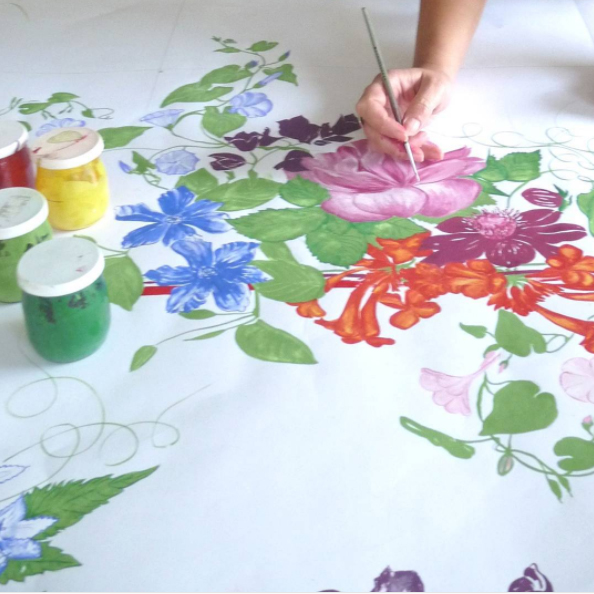
But one of the town’s best-kept secrets is a little family-owned factory called Beauville, which has been producing linens for over 200 years. Their clients include Hermes, Pierre Frey, Cowtan & Tout, Ralph Lauren, Catherine Deneuve, the Royal Court of Sweden, and the White House, and they’ve been a favorite amongst our customers for several years now.
Recently, I spent some time finding out just what their secret was. I was amazed by what I saw — it’s not what they make, but how they do it.

The colors used on each Beauville fabric are prepared in the factory’s color kitchen; a total of 25 base colors are used to create an infinite range of shades.

Using these colors, Beauville’s designers and colorists create two new collections of linens each year. Many of the more traditional patterns are inspired by 18th and 19th century French woodblock designs, while the newer styles are created in-house.
Here is a rendering of a spring design:

At work on the ever-popular Coral collection (found on yachts and beach houses around the world):

And here, gouache paints and brushes are used to create a holiday collection:

Once the designs have been created, a screen is created for each color used. Below, two printers carefully lift up a printing screen to place on the fabric. This must be done very precisely, or the design won’t be produced correctly. Using a squeegee, color is then evenly spread across the screen onto the cloth. Each application of color requires the use of a new screen.

Up to 20 colors are used on each collection, so the company’s designs are noted for their vibrancy.

Once the fabrics are printed, they are steamed to set the dyes in the fibers, thus making them colorfast.

During production, quality is checked six times to ensure the prints are carefully made and colors are correctly applied.

And for easy care, many of Beauville’s newest collections are stain-repellent, so spills can easily be wiped off:

Every piece is singed, bleached, designed, printed, sewn, and finished in-house.

And here they are, ready to be packed:

Although Beauville is known for more traditional French and floral designs, here’s something unique: a woodblock printed panel which won First prize at the Exposition Universelle of 1900 in Paris. This panel is part of a series of four panels purchased by the Emperor of Japan to decorate the dining room of the Imperial Palace in Tokyo. In the midst of this sumptuous garden you can see six women dressed in majestic traditional costumes.

Beauville was awarded the “Entreprise du Patrimoine Vivant” label in 2009, given to French firms for their excellence in their traditional and industrial skills. There are currently fewer than ten firms throughout France with similar printing skills. Bravo!
To see all of Beauville’s collections, click here.
Like this post? Sign up for our email list to get news and special offers!
